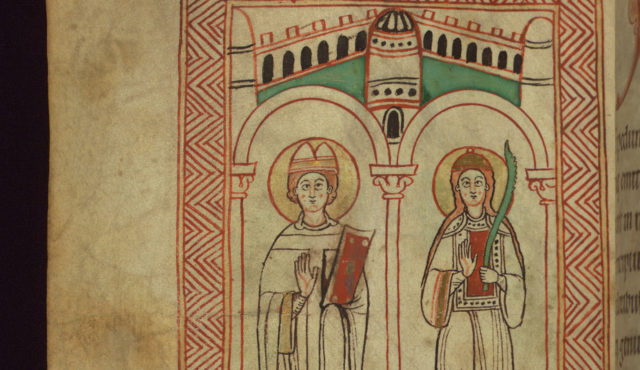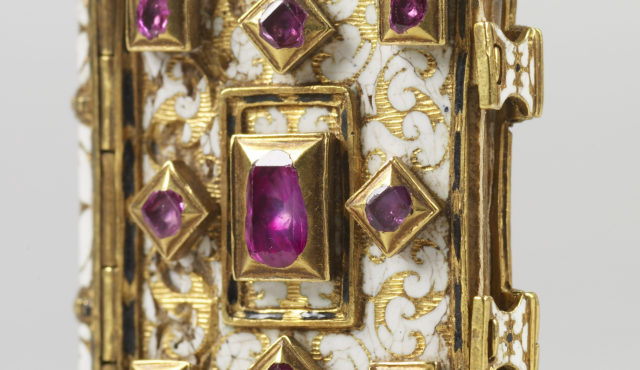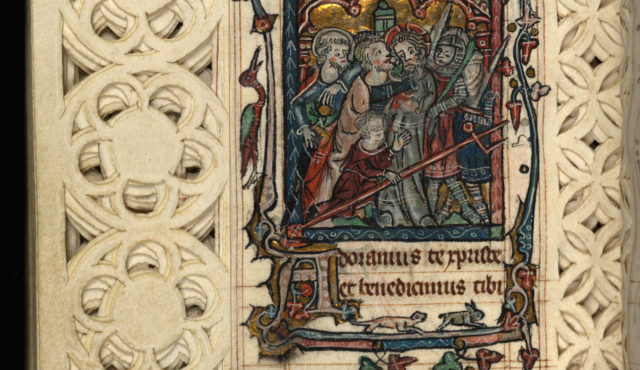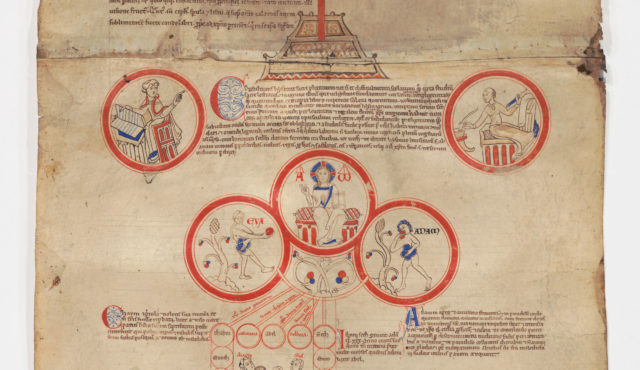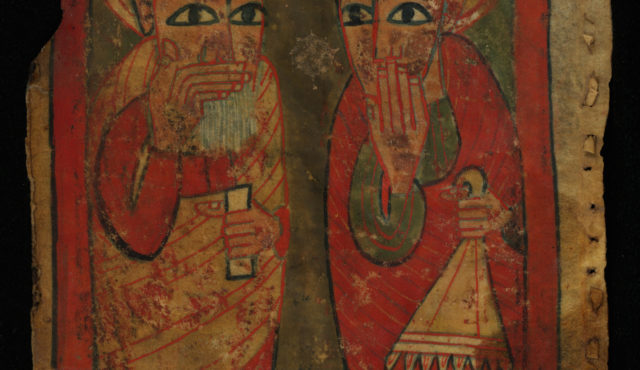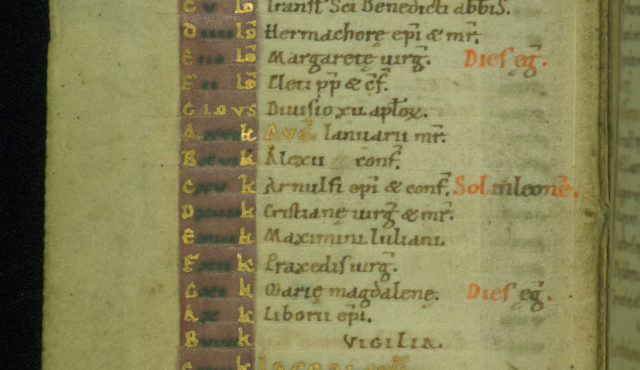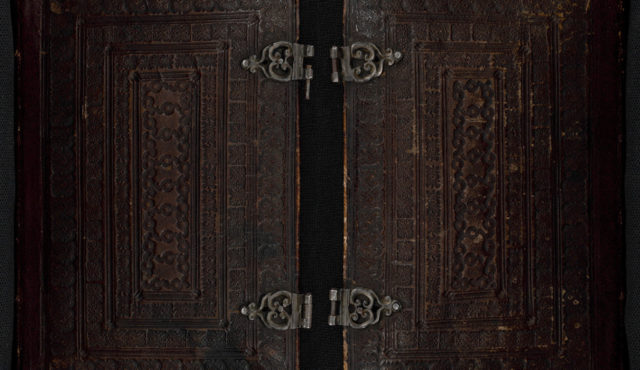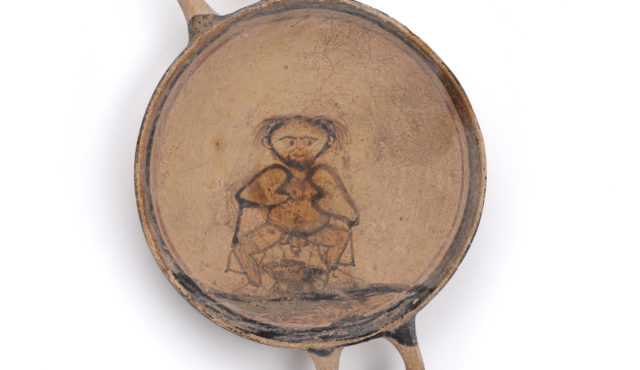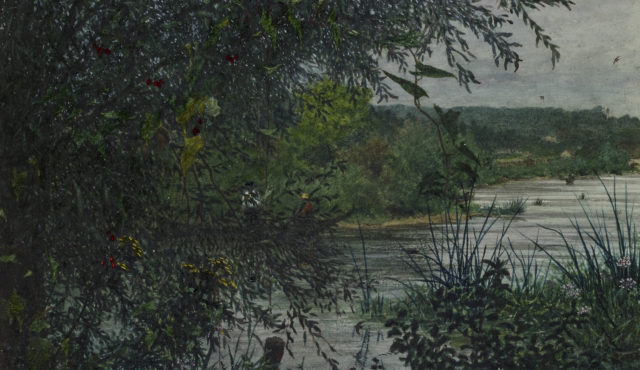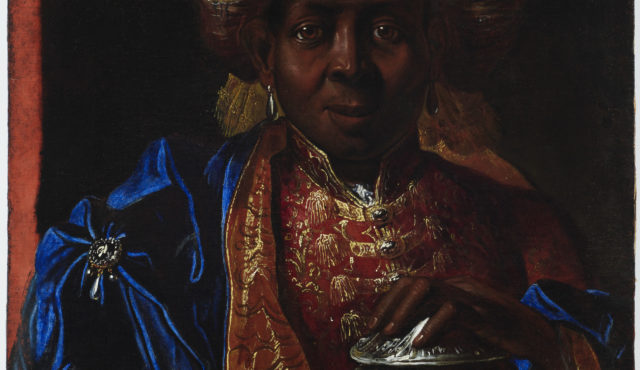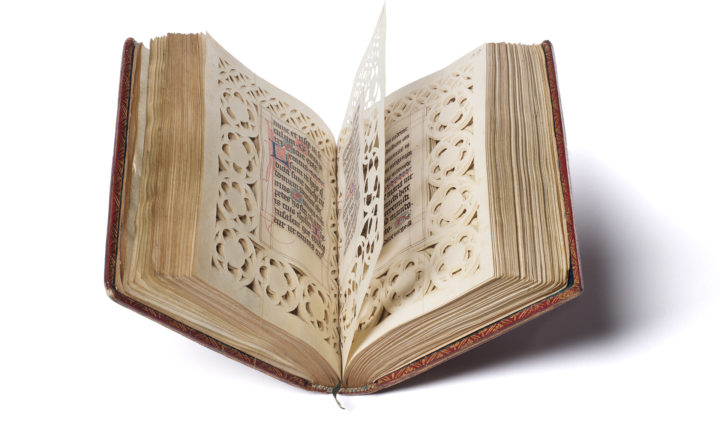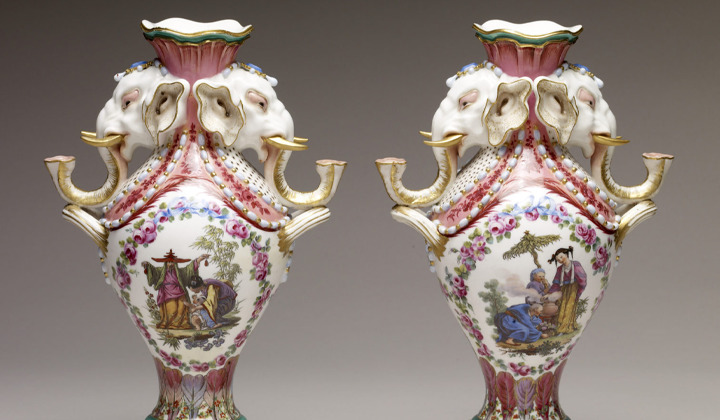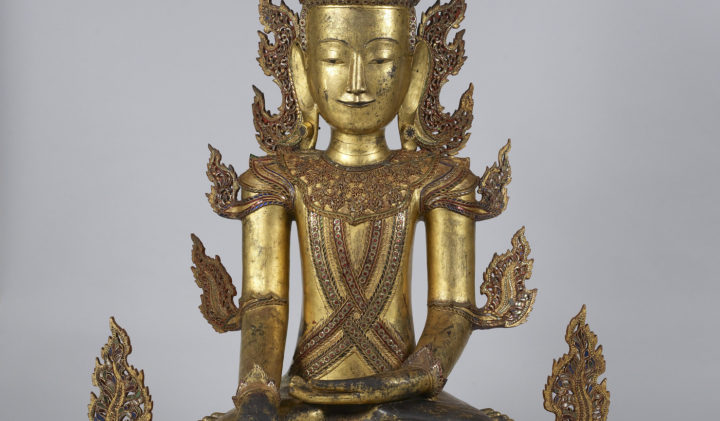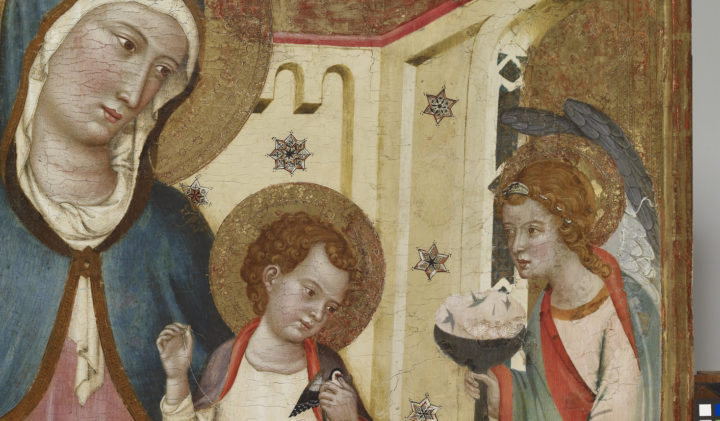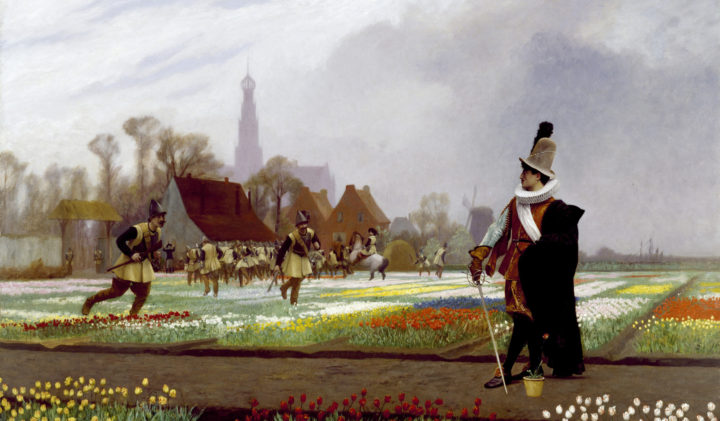The “Sam Wide Group” is the name assigned by art historians to a ceramics workshop in fifth-century-BCE Greece; it is named after the first scholar who published examples of ceramic vessels that were identified as having been produced by this workshop.[1] Aside from seventeen previously known vessels held in museums, fragments of vessels are the bulk of what remains of the production of the Sam Wide Group. Most of the fragments were found in excavations at the ancient city of Corinth, with dozens of examples having been excavated in the Potters’ Quarter and the Sanctuary of Demeter and Kore there.[2] The vessels are generally small kylikes (shallow two-handled drinking cups), but plates and pyxides (lidded boxes) are also known, and production of the group is generally dated to the late fifth century BCE.[3] The Walters Art Museum houses a previously unknown kylix produced by this workshop. The kylix at the Walters bears unusual image and a unique inscription that are difficult to interpret, so the purpose of this note is to bring attention to this vessel through publication, with the hope that more people will weigh in on its significance.
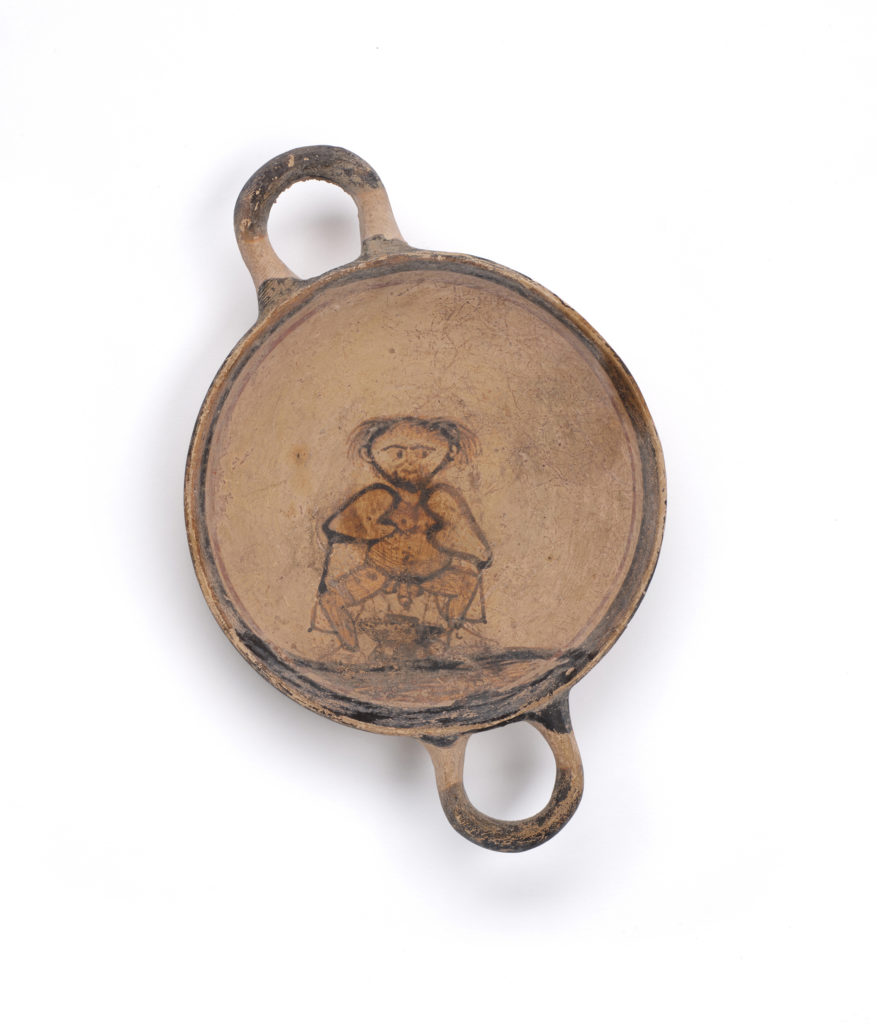
Sam Wide Group, Kylix with Grotesque Figure, Corinth, Greece, 2nd half 5th century BCE, terracotta. The Walters Art Museum, Baltimore. Bequest of Beatrice A. Kelekian in memory of Mr. and Mrs. Charles D. Kelekian, 1992, acc. no. 48.2708
The clay of this small kylix (H: 2.3 cm; max W with handles: 14.2 cm; diam. of bowl: 9.2 cm) is a creamy color typically seen in pottery attributed to Corinth (fig. 1); the other vessels and vessel fragments attributed to the Sam Wide Group have the same creamy-colored clay. The interior of the bowl of the Walters vessel shows an adult man in frontal view crouching over a vessel being used as a chamber pot; he is nude except for a cloak shown behind him, rendered in simple outline.[4] The man is bearded and has long, wild hair on the sides of his head, although he appears to be bald on top. His bare belly is large and round; his arms are crudely drawn and appear to be bent at the elbows, with no hands indicated. The man’s knees are bent while he squats, with his penis and testicles dangling over the chamber pot.[5] His feet are planted firmly on the black ground, which is roughly filled in. Like other Sam Wide Group vessels, the area behind the figure is left undecorated. The orientation of the figure and ground line is noticeably not aligned to the handles.[6] The interior of the lip bears a wide black band, with a reddish-brown thin line below that; the handles are black tipped, with the color visible on the front and back. On the exterior, there is a band of black marks that is bordered at the top and bottom with a narrow black line (fig. 2). The ring foot also bears a black band around its circumference (diam. of foot: 4.1 cm). Uniquely among the Sam Wide Group, this vessel bears a dipinto (painted inscription), which will be discussed later in this note. There is minor loss of added color and chipping of the surface, particularly around the lip, the underside of the handles, and the foot, but the vessel otherwise appears to be intact.
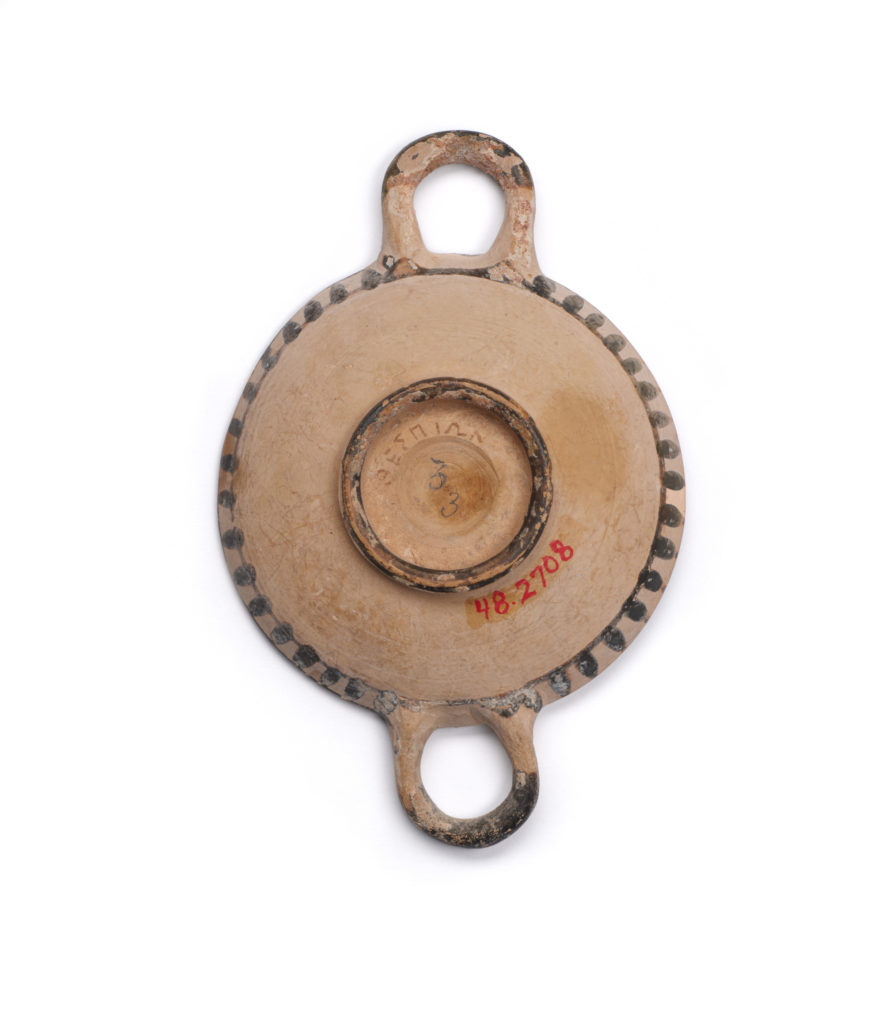
Underside of acc. no. 48.2708. The slight discoloration above and to the right of the red accession number is where the collection sticker had been adhered (see Figure 7).
The “Sam Wide painter” and, less commonly, the “Herakles painter” are two suggested names for the main painter involved in the workshop—while there may have been more than one painter for the group, the clear similarity of the objects and images as well as the short period assumed for their manufacture indicate only a few artisans were involved in their creation.[7] The images on the vessels and fragments attributed to the Sam Wide Group are drawn very simply, with little detail or incision, and the figural compositions are described as having an “outline” or cartoonish quality. Some of the images depict goddesses and the divinized hero Herakles,[8] while others include references to mythical creatures like sphinxes and centaurs.[9] Men and women are also shown engaged in activities ranging from horse riding to playing the drinking game known as kottabos.[10] Depictions of plants that are identified as lotuses are the most popular decoration.[11] In general, the vessels are thought to have had a ritual purpose, although their “crudeness” and “humor” have also been noted by previous scholars.[12] The most unusual, and explicit, vessel of the group previously known is a kylix at the Ashmolean Museum, Oxford, shows a masturbating sphinx leering at a cartoonish Oedipus, a parody of the story of Oedipus answering the riddle of the sphinx (fig. 3).[13] The defecating man shown on the Walters kylix is unique among vessels in the Sam Wide Group. Another vessel that has been suggested as having a comical intent is a kylix in the Cycladic Museum, Athens, shows a nude man walking while holding out the stick-like fingers of one hand (fig. 4).
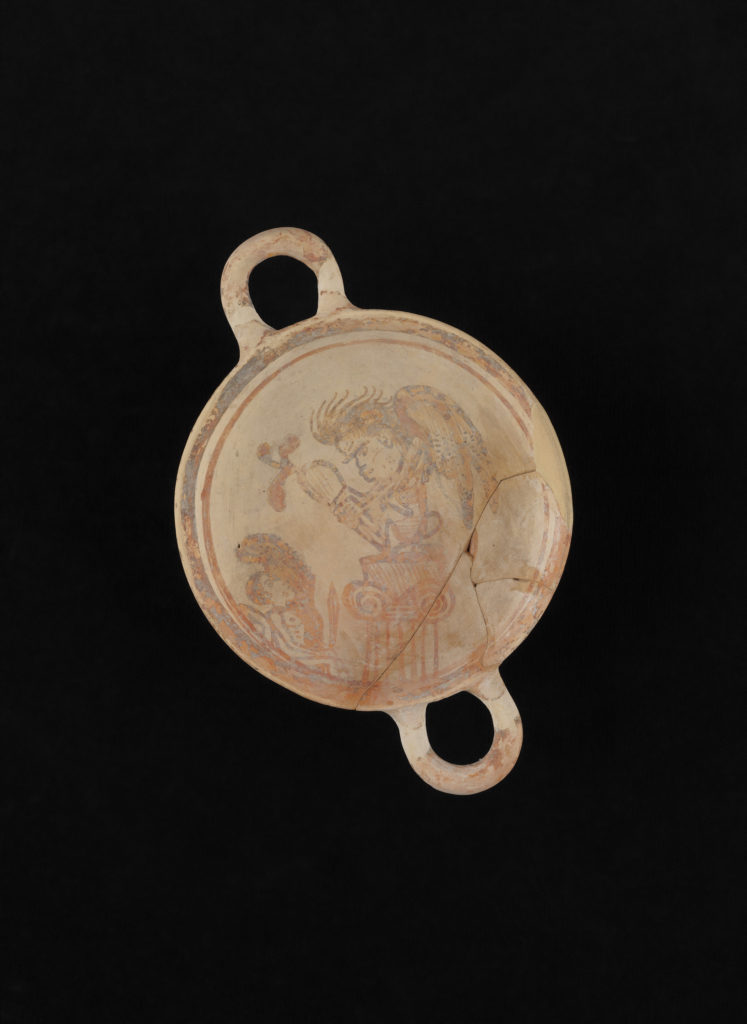
Sam Wide Group, Kylix with a Parody of Oedipus and the Sphinx, Corinth, Greece, late 5th century BCE, terracotta. Ashmolean Museum, Oxford, acc. no. AN2008.34
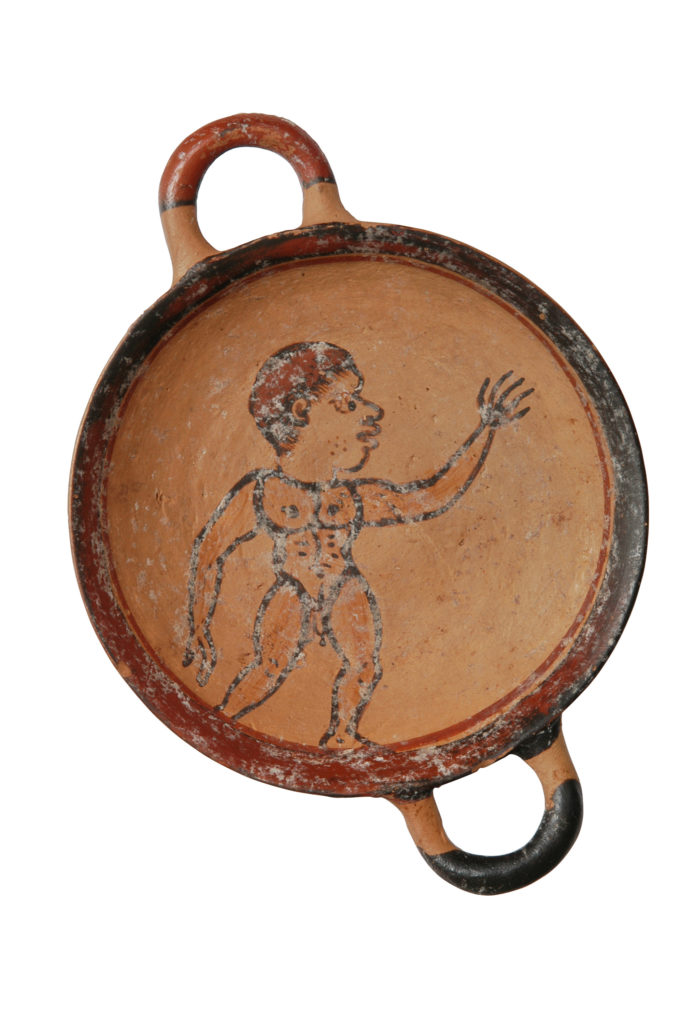
Sam Wide Group, Kylix with a Nude Man, Corinth, Greece, late 5th century BCE, terracotta. © N.P. – N. Goulandris Foundation – Museum of Cycladic Art, Athens. ΝΓ0030.
Defecation scenes on Greek vases are uncommon but were clearly meant to be humorous. This imagery is directly linked to overindulgence and excess, whether involving humans or satyrs engaging in drinking and debauchery.[14] A vessel at the Musée du Louvre, Paris, is an excellent example of this, and a good parallel for the specific depiction on the Walters kylix even though it was produced a century earlier (fig. 5). It shows a lively komos (a ritual drunken procession) dancing and drinking, and includes a nude, portly man standing in profile who appears to be defecating; in this early period, the members of the komos, known as komasts, often appear to wear padding on their bodies. The tondo (decorated circle on the interior) of an early fifth-century-BCE cup in the collection of the Musées Royaux d’Art et d’Histoire, Brussels, shows a young man with an ivy wreath on his head; the young man is nude except for a cloak thrown around his shoulders, and he is shown crouched down while simultaneously urinating and defecating[15] The frontal positioning of the man on the Brussels vessel is similar to that of the Walters cup; a further similarity is the way his cloak is conspicuously open to show, even to highlight, his naughty actions. The young man on the Brussels cup can also be identified as a komast; when depicted on red-figure vessels, inebriated revelers are often identified as komasts even without padding. Another defecation scene appears on a fifth-century-BCE vase fragment at the Acropolis Museum in Athens, which shows a man with a comically large head, much like a caricature, defecating and holding his nose.[16] This kind of caricature can be compared directly to vessels in the Sam Wide Group where the figures are also drawn with disproportionately large heads, although the figures are much more dignified than the man on the Athenian fragment.[17] It is possible that the figure on the Walters Sam Wide Group kylix is an isolated member of a komos who is behaving quite badly. Perhaps the nude figure at the Cycladic Museum in Athens is also a member of the same komos, and it is possible that there might have originally been more cups depicting other members of the komos.
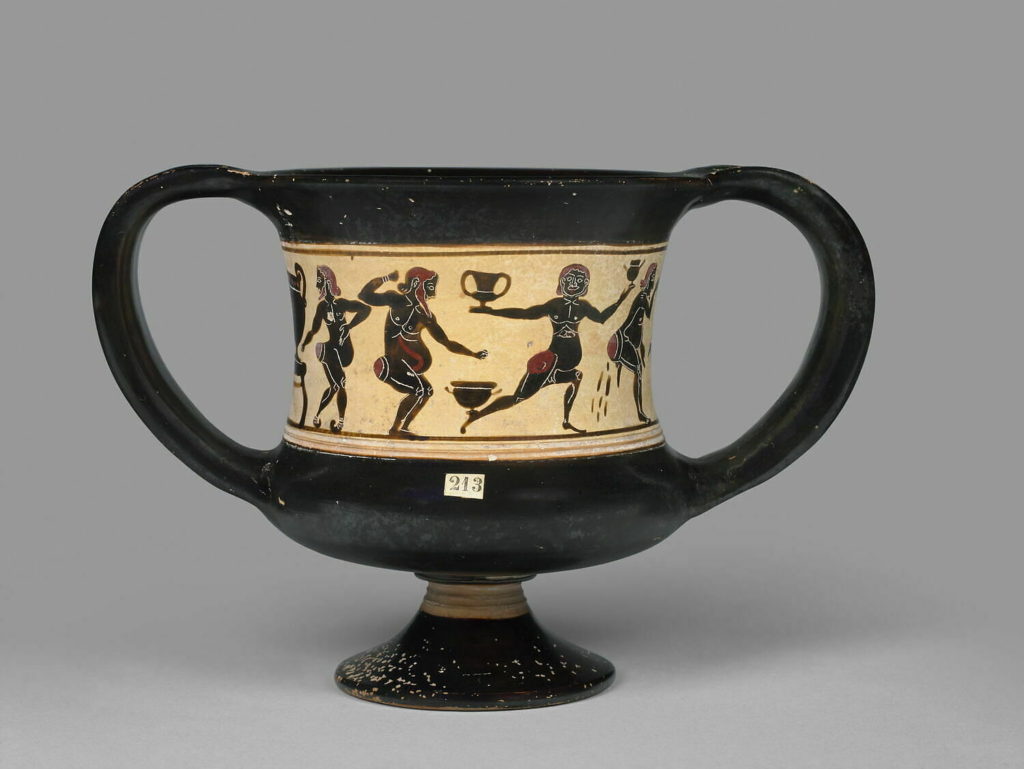
Kyathos with a Komos Group, Laconia, Greece, ca. 550–540 BCE, terracotta. Musée du Louvre, Paris, acc. no. MNE 1324. © 2017 Louvre Museum / Hervé Lewandowski
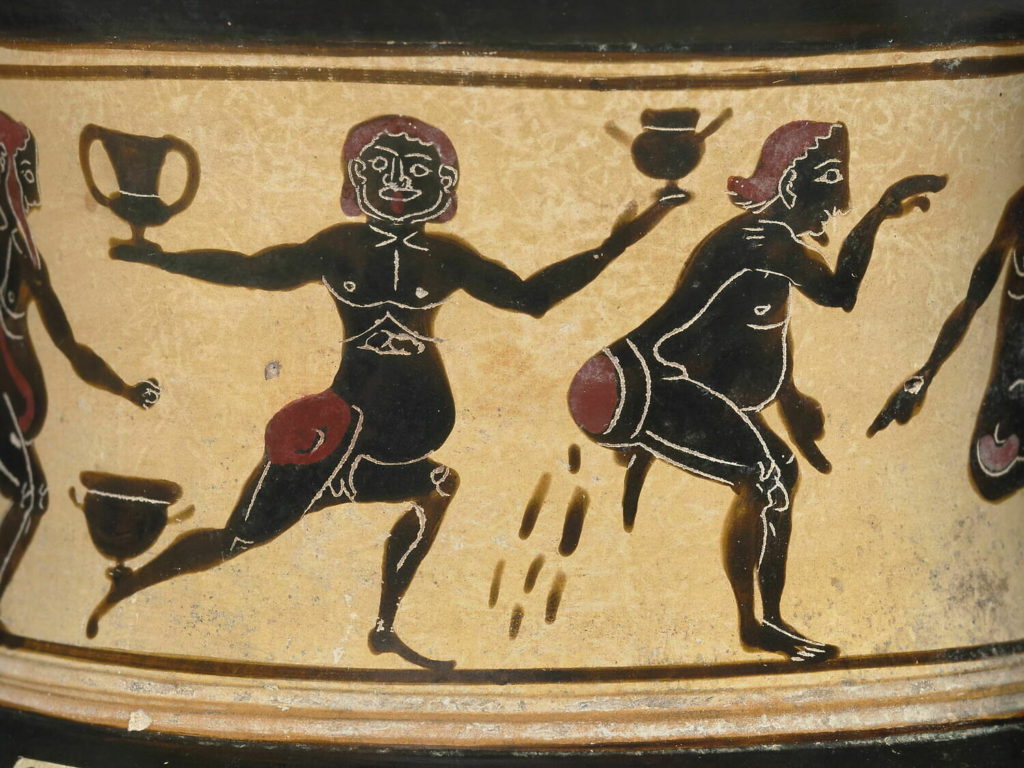
Finally, the shape of the chamber pot depicted on the Walters kylix is unusual; it has a bowl that expands at the top, contracts where it connects with the foot, and then flares out again at the bottom. There is a Greek word for chamber pot, ἀμίς (amis),[18] and a banded, round-mouthed vessel excavated in the Agora at Athens is labeled by a graffito as an “amis,” but the shape that appears below the man on the Walters kylix is not the same as the amis found in Athens.[19] Depictions on other figural Greek vessels show a man urinating into a one-handled oinochoe (wine vessel), usually of the same form as might be expected for pouring wine—it is possible that the vessels used as chamber pots were generally not intended to function initially, or at least only, as chamber pots.[20] The vessel depicted on the Walters kylix may represent a brazier for cooking food or for burning incense[21] or a stemmed perfume vessel known variously as a plemochoe, a kothon, or an exaleiptron[22]—if any of these forms was intended, it would add to the transgressive humor of the scene, whether he was despoiling food, desecrating an offering, or disguising his “scents” with incense or perfume.
The Inscription: “Of the Thespians”?
A dipinto (painted inscription) in Greek made up of very fine brown strokes reading ΘΕΣΠΙΩΝ (Thespiōn) is on the underside of the cup (the letters range from circa 2–4 mm high and 1–4 mm wide) (fig. 2). This is the only known instance of an inscription on a Sam Wide Group vessel.[23] The letter forms help to confirm the late fifth-century-BCE date for the cup and for the group.[24] The word is plural and in the possessive (genitive) case. It could be translated as “Of the Thespians,” that is, “of the people of the city of Thespiae,” which is near modern Thespies in Boeotia (fig. 6). Instances of “Thespiōn” referring to the people of Thespiae occur in late fifth- to early fourth-century-BCE historical texts by authors such as Thucydides and Xenophon.[25] The inscription could also refer to the city itself and be translated as “Of (the city of) Thespiae.”[26]
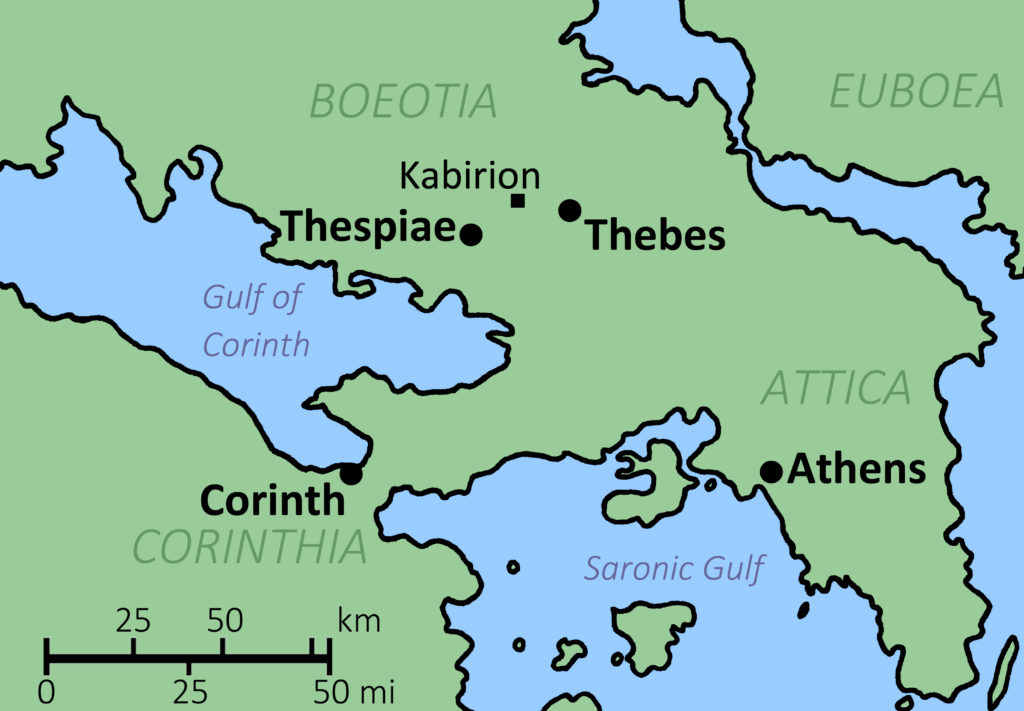
Map of Greece highlighting Corinth, Thespiae, the Kabirion Sanctuary, and Thebes
It should be stated that although “of the Thespians” might seem to a modern reader to be connected to actors, this is certainly not what it means here. Uses of “thespian” to refer to actors or acting are attested from the seventeenth century at the earliest.[27] The ancient Greek word for actor was ὑποκριτής, (hypokritēs), which can be translated as “one who plays a part, a player, an actor, a pretender”—whence the English word hypocrite derives. The name for the city of Thespiae and the word thespian meaning “actor” are related, however, by the legendary Thespis, who lived in the sixth century BCE and was said to have been the first actor.[28] His name derives from the word θέσπις (thespis), an adjective that can be translated as “divinely inspired,” but can also mean “wondrous” or “awful.” Therefore, it is also possible that this form could be understood as meaning something like “of the divinely inspired ones,” although all other attested literary and epigraphic instances of “Thespiōn” in the genitive plural refer to the people of Thespiae.
Inscriptions on vases of the sixth to fifth centuries BCE took many forms, including labels (i.e., identifying figures or describing them as “beautiful”), “exclamations” (i.e., words said by the figures depicted, sometimes nonsense), dedications (often from a person to a deity), and signatures identifying the potter and/or painter.[29] Inscriptions on vessels indicating possession are especially rare. On the other hand, the grammatical form of the genitive plural of a city or population appears frequently on Greek coins proclaiming the issuing authority.[30] It is not clear in this instance whether the inscription on the cup is meant to imply ownership of the cup by the people of Thespiae or by “divinely inspired people,” to state that it was made by the people of Thespiae or by “divinely inspired people,” or if it is meant to insult the people of Thespiae or “divinely inspired people” by suggesting this behavior is typical of them. In the Sanctuary of Demeter and Kore at Corinth, pinakes (plaques) with inscriptions in the genitive case have been excavated, and while the scholar who published the inscriptions suggests that the objects belong to the individual or deity whose name is in the genitive, he also noted that for the inscribed pinakes “the full force of the genitive…is not clear.”[31] Ultimately, this word, in particular its various interpretations, is the most puzzling aspect of this cup.
Some of the early debate about the Sam Wide Group focused on its place of manufacture. Sam Wide believed the vessels were produced in the region of Boeotia, although none have been found in excavations there, and other scholars accepted this attribution until excavated remains indicated another location.[32] Fragments have been excavated only at the city of Corinth (in Corinthia), particularly in the Potters’ Quarter and the Sanctuary of Demeter and Kore, establishing Corinth as the location where the Sam Wide Group worked and where their ceramic vessels were used.[33] While it is unlikely that this dipinto will change any opinions on where the Sam Wide Group was produced, there is another connection, related to the potential meaning of the dipinto, that should be explored. Thespiae is very close to the Kabirion Sanctuary (located 10 km east of Thespiae, and 8 km west of Thebes, the capital of Boeotia), which was home to the mystery cult of the Kabirioi, who were associated with the goddesses Demeter and Kore.[34] Kabirion ware, the corpus of which is much more extensive than that of the Sam Wide Group, is known for its burlesque or humorous subject matter, and the Sam Wide Group has frequently been studied in conjunction with Kabirion ware due to the similarity of the depictions.[35] Although the two ceramic wares were produced contemporaneously, the connection between Sam Wide Group and the producers of Kabirion ware was not considered to be strong due to the relatively few surviving burlesque images on Sam Wide pottery. The Walters kylix may help to strengthen the link between the two groups of pottery, not only with its explicit imagery but also by directly referencing a city near the Kabirion sanctuary.[36] Could there have been a little playful inter-sanctuary rivalry? Both sanctuaries are dedicated to or closely associated with Demeter and Kore, and at both the Kabirion and the sanctuary at Corinth, locally produced ceramics with a unique artistic style—the Kabirion ware and the Sam Wide Group vessels, respectively—were decorated with scenes of mythological parody and humor. Interpretation of the transgressive, humorous, and burlesque ceramic images at the Kabirion sanctuary as part of the carnival atmosphere that occurred during religious festivals also helps to contextualize the extreme examples of “humor” in the Sam Wide Group from the Corinthian sanctuary. Whatever the purpose of the vessels and of the images, they were appropriate in these particular religious contexts.
Conclusion
The Sam Wide Group kylix at the Walters Art Museum is uncomplicated, if explicit, in its imagery, but its dipinto makes it difficult to interpret fully. It is certainly the product of the Sam Wide Group workshop, and the image of the man, probably part of a komos, defecating into a vessel functioning as a chamber pot on one side is a clear example of humor or burlesque imagery. While the letters of the painted inscription inside the foot are clear, their meaning is ambiguous and the connection between the inscription and the image, if there is one, is not obvious. The inscription may have been meant to mock the city or the citizens of Thespiae, or perhaps those of the nearby Kabirion sanctuary. It may have been meant to suggest a form of ownership or production. It may also have evoked “divinely inspired,” “awesome,” or “awful” behavior that might arise as part of ritual revelry. Or it could mean something else not explored here. Hopefully, this note will spark further investigation of the Sam Wide Group as well as its connection to Corinth and the Sanctuary of Demeter and Kore there.
Addendum: Provenance

Collection sticker of Charles Dikran Kelekian that was previously adhered to the underside of 48.2708
According to the current publications policy of the Archaeological Institute of America, this kylix is considered to be unprovenanced, that is, without secure ownership history prior to 1970.[37] But as provenance researchers work on ways to record the ambiguities of object provenance in a complete and regularized way, it is worth briefly stating the known ownership history of this cup and indicating how secure each portion of the provenance is. This cup was part of the bequest of Beatrice Kelekian (died 1992) to the Walters Art Museum in 1992.[38] All of the ninety-two objects in the bequest had been part of the collection of her late husband Charles Dikran Kelekian (died 1982), son of Dikran Kelekian (died 1951), with whom Henry Walters had a close collaboration from when they first met at the 1893 World’s Fair in Chicago until Henry Walters’s death in 1931. On the bottom of the kylix, the number “33” is written in what appears to be pencil—nothing more is known about what this number signifies, but it is likely an inventory number from a previous collection. A white collection sticker with a blue border was previously adhered to the underside of the bowl—the sticker was still on the bowl in 2018 but has since fallen off due to age (fig. 7). On the sticker written in black ink is “Ction \ C. D. Kelekian \ No. 203.” This can be expanded to “Collection of Charles Dikran Kelekian, number 203”—many other objects from this bequest have the same sticker, with the information written in the same order.
The pre-1992 history of the cup is corroborated by the description in the “Shipment List, Paris to NY, c. 1950” preserved in the Kelekian archive, held at the Metropolitan Museum’s Onassis Library for Hellenic and Roman Art (fig. 8).[39] On page 22, inventory number “203” is catalogued as a “Greek kylix sm(all), tan ground, male pornographic fig(ure), signed Vespion” (sic).[40] While this provenance is not quite as secure as if it had appeared in a widely available publication with an image, there is no mistaking that this description fits the Walters kylix. The fact that the inventory book had been on deposit since 2003 at the Met (and before that from 1987 at NYU’s IFA) adds some security to the provenance. While the first completely verifiable date in the kylix’s provenance is 1992 when it was deposited at the Walters, it seems fairly certain it was in the Kelekian collection in Paris by 1950. As an intact vessel, it may have come from a burial, but no other information about its original findspot has yet been found.[41]
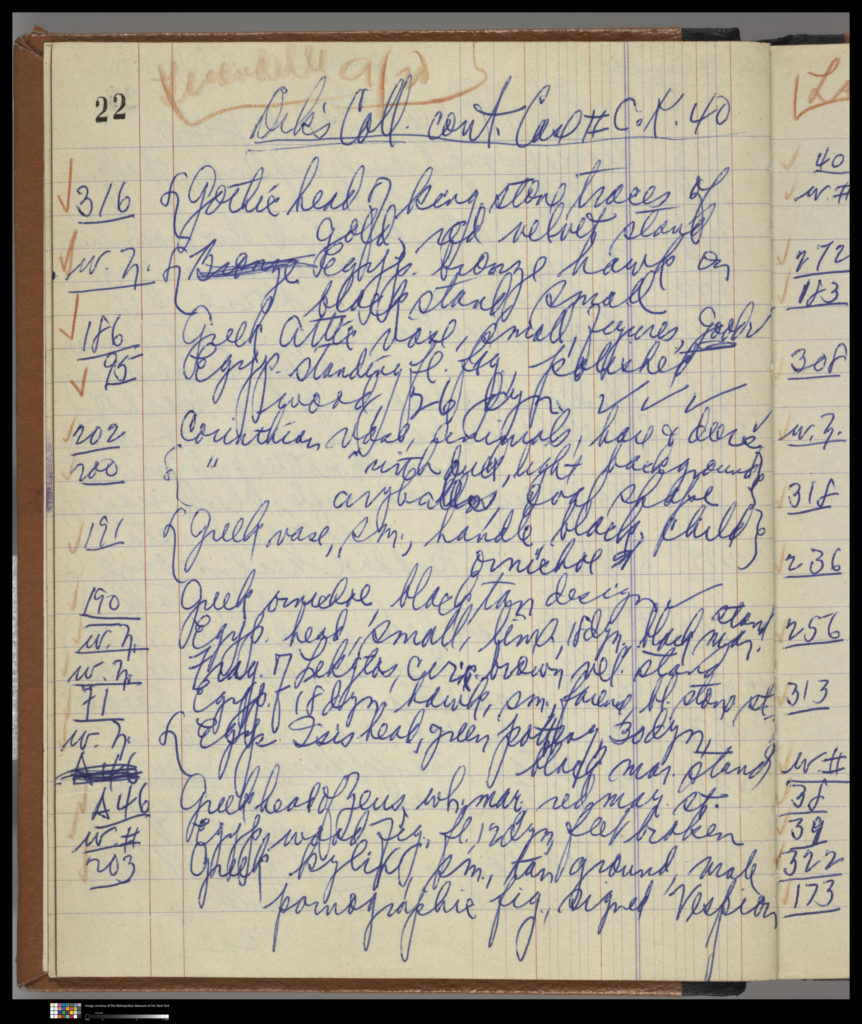
Page 22 of “Shipment List, Paris to NY, c. 1950” in the Kelekian Archive at the Metropolitan Museum of Art. The entry at the bottom is for this cup (48.2708). “Shipment List, Paris to NY,” ca. 1950, The Kelekian Archive, The Department of Greek and Roman Art, The Metropolitan Museum of Art, New York, File F, Inventory Lists File Number 2, Folder C, p.22. © The Metropolitan Museum of Art. Image source: Art Resource, NY
Object Biography
Creation: late 5th century BCE, Corinth, Greece
Deposition: date and location unknown
Excavation: date and location unknown
Collection: 1) collector, location, and date unknown, no. 33, not secure [source: pencil mark]; 2) Charles Dikran Kelekian, by 1950, Paris, no. 203, semi-secure [source: inventory held in an archive]; 3) Walters Art Museum, Baltimore, 1992, no. 48.2708, secure [source: deposition in a museum].
[1] Sam Wide, “Eine lokale Gattung boiotischer Gefässe,” Mitteilungen des Deutschen Archäologischen Instituts, Athenische Abteilung Vol. 26 (1901): 143–56, pl. 8. For the naming of the group, see also John Boardman, “A Sam Wide Group Cup in Oxford,” The Journal of Hellenic Studies, Vol. 90 (1970): 194–95 and https://www.britishmuseum.org/collection/term/BIOG60436.
[2] Darrell A. Amyx, Corinthian Vase-Painting of the Archaic Period (Berkeley: University of California Press, 1988), 275–76; Agnes N. Stillwell, “Appendix III: The Sam Wide Workshop,” in Agnes N. Stillwell and J. L. Benson, Corinth 15.3. The Potters’ Quarter: The Pottery (Princeton, NJ: ASCSA, 1984), 368–71; and Martha K. Risser, Corinth 7.5. Corinthian Conventionalizing Pottery (Princeton, NJ: ASCSA, 2001), 160–72, nos. 674–719 (excavated pieces) with an addendum listing vessels held in museums.
[3] Martha K. Risser, “Corinthian Archaic and Classical Pottery: The Local Style,” in Charles K. Williams II and Nancy Bookidis, eds., Corinth 20. Corinth: The Centenary, 1896–1996 (Princeton , NJ: ASCSA, 2003), 157–65.
[4] The frontality of the composition and others in the group is striking, because in this period of Greek art most humans and animals were depicted in profile on vessels and reliefs. See also a Sam Wide Group kylix in the National Museum, Athens, acc. no. 484, with a man standing frontally, wearing a cap (pilos) short chiton, and mantle, holding a slingshot (illustrated in Wide, “Eine lokale Gattung boiotischer Gefässe,” 147).
[5] For discussions on how the man’s round belly and large, dangling penis are humorous and imply behavior outside normal expectations, see, for example, David Walsh, Distorted Ideals in Greek Vase-Painting: The World of Mythological Burlesque (New York: Cambridge University Press, 2009), chap. 7 “Distorted Bodies,” 245–58; and Timothy J. McNiven, “The Unheroic Penis: Otherness Exposed,” in Source: Notes in the History of Art 15.1 (1995): 10–16.
[6] This is a feature of other Sam Wide Group kylikes. Compare a kylix at the British Museum, London, acc. no. 1969,1215.2, late 5th century BCE, which shows a woman, perhaps Artemis, holding a torch and bow and approaching an altar while accompanied by a dog.
[7] For the suggested naming of the painter, see Stillwell, “Appendix III: The Sam Wide Workshop,” 370, n.1.
[8] See the kylix at the Ure Museum, Reading, acc. no. 47.8.1, late 5th century BCE.
[9] For a centaur and tortoise, see the kylix at the State Hermitage Museum, St. Petersburg, acc. no. ГР-8372, late 5th century BCE.
[10] To play kottabos, the drinker uses his or her cup to throw dregs of wine at a target. For a female kottabos player, who is shown in a very dignified manner in spite of the game she is playing, see a kylix at the British Museum, London, acc. no. 1873,0915.9, late 5th century BCE. Other depictions include the deity Pan, warriors, a man wearing a pilos with a slingshot, and a nude man; for a list of known vessels and fragments, see Risser, Corinthian Conventionalizing Pottery, 165–72.
[11] Approximately half of the known examples of the Sam Wide Group are described as having a lotus as the main decoration; see Risser, Corinthian Conventionalizing Pottery, 165–72. See for example a kylix on loan at the Ure Museum, Reading, acc. no. 1935.87.11, late 5th century BCE; the online entry for this vessel identifies the plant as a rosebud but notes that the authors of the Corinth series identify it as a lotus. The identification of the plant depicted certainly needs a reassessment.
[12] See Erin Thompson, Images of Ritual Mockery on Greek Vases (PhD diss., Columbia University, 2010) chap. 6 “Aischrologia,” 159–215; and Boardman, “A Sam Wide Group Cup in Oxford,” 195. Amyx, Corinthian Vase-Painting of the Archaic Period, 275, notes that “subjects range from solemn religious themes to what seem to be burlesques or parodies with no clear line of division.”
[13] See Boardman, “A Sam Wide Group Cup in Oxford,” 194–95. Previously on long-term loan, it is now accessioned into the Ashmolean’s collection as AN2008.34. Boardman also suggested that the sphinx was defecating in excitement.
[14] A search for “defecating” in the Beazley archive, the largest online database of Greek vases, returns fewer than twenty results. Most show satyrs or young men; a few defecating dogs also appear—for more on this, and the humor evident in the depictions of defecating dogs, see Seth Pevnick, “Good Dog, Bad Dog: A Cup by the Triptolemos Painter and Aspects of Canine Behavior on Athenian Vases,” in John H. Oakley, ed., Athenian Potters and Painters III (Oxford: Oxbow, 2014), 155–64.
[15] Scheurleer Painter (late 6th–early 5th century BCE), Musées Royaux d’Art et d’Histoire, Brussels, acc. no. R259. There is also a dipinto on the object that can be translated as “the boy is beautiful” and probably ought to be read as mocking the youth depicted.
[16] Acropolis Museum, Athens, acc. no. 2.1073, second half of the 5th century BCE.
[17] See, for example, a kylix at the Ure Museum, Reading, no. 64.7.1, which shows a woman with a large head holding a lotus or poppy; see also Elizabeth G. Pemberton, Corinth 18.1. The Sanctuary of Demeter and Kore: The Greek Pottery (Princeton, NJ: ASCSA, 1989), 136, no. 297, pl. 32.
[18] This is defined as specifically a chamber pot or urinal for men; chamber pots for women were called σκάφιον (skaphion). The term “amis” appears mostly in the plays of the 5th-century-BCE comedian Aristophanes—usually translated into English as a “thunder mug,” which is an old-fashioned euphemism for a chamber pot.
[19] Vessels of the same shape of the Athenian example may have been used for water, as most examples were found in the lowest layers of wells. See Brian A. Sparkes, Lucy Talcott, and Gisela M. A. Richter, The Athenian Agora 12. Black and Plain Pottery of the 6th, 5th and 4th Centuries B.C. (Princeton, NJ: ASCSA, 1970), 8, 65, and 231, nos. 2012–13, fig. 14. The illustrated example certainly looks like a purpose-made urinal.
[20] Compare an oinochoe at the J. Paul Getty Museum, acc. no. 86.AE.237, ca. 470 BCE, that shows a man urinating into an oinochoe held by a servant. On a kylix in a private collection, a drunken youth is shown defecating into a two-handled kylix, while another, presumably his drink cup, is poised in front of him, perhaps indicating that different types of vessels might be used or that whatever was available might be appropriated as a chamber pot.
[21] Compare the shape of miniature vessels found in the Potters’ Quarter at Corinth and identified as incense burners in Stillwell and Benson, The Potters’ Quarter: The Pottery, 334, nos. 2007–2008, pl. 72.
[22] See for example, a vessel at the Walters Art Museum, acc. no. 48.2081, late 6th–early 5th century BCE. Compare also an example at the Metropolitan Museum, New York, acc. no. 07.286.46,a,b, late 6th century BCE.
[23] It is also unlike the known instances of dipinti and other inscriptions on vessels found at Corinth. See, for example, Alan L. Boegehold, “Appendix I: Inscriptions,” in Stillwell and Benson, The Potters’ Quarter: The Pottery, 358–62; and Ronald S. Stroud, Corinth 18.6. The Sanctuary of Demeter and Kore: The Inscriptions (Princeton, NJ: ASCSA, 2013).
[24] Lilian Hamilton Jeffery, The Local Scripts of Archaic Greece: A Study of the Origin of the Greek Alphabet and Its Development from the Eighth to the Fifth Centuries B.C. (Oxford: Clarendon Press, 1961).
[25] Thucydides 4.96.3, 4.133.1, 6.95.2, and 7.25.3; Xenophon Hellenica 5.4.20 and 6.3.5. An alternative form “Thespieon” appears on later Hellenistic coins from Thespiae and in some editions of ancient texts, like Herodotus’s Histories, depending on the manuscript tradition or the decision of the texts’ editors.
[26] Strabo the geographer notes (9.2.25) that the name of the city of Thespiae could grammatically be both singular and plural.
[27] Oxford English Dictionary, 2nd edition, “Thespian;” see also Online Etymology Dictionary: https://www.etymonline.com/word/thespian.
[28] See “Thespis (TrGF 1)” in Martin Cropp, ed., Minor Greek Tragedians 1: The Fifth Century (Oxford: Oxford University Press, 2019), 1–17. Thespis and other etymologically related names are attested by inscriptions from the Classical to the Roman periods; see the Lexicon of Greek Personal Names updated at http://www.seangb.org.
[29] Painter and potter names, as well as “kalos” inscriptions and labels are written in the nominative case, while exclamations are in a variety of cases, and nonsense inscriptions are nonsense. Graffiti and dipinti on the feet of vessels are usually related to who produced and/or decorated the vessel.
[30] William E. Metcalf, The Oxford Handbook of Greek and Roman Coinage (Oxford: Oxford University Press, 2012), 4.
[31] Stroud, The Sanctuary of Demeter and Kore: The Inscriptions, 71–80. On these pieces, he concludes that “…until there is some illumination from other similar objects with documented functions, or until an explanatory passage in literature or an inscription can be adduced, I have to leave the interpretation of these puzzling objects to my readers” (p. 80).
[32] Wide based this opinion on the ceramic “fabric” of the five examples he published (two at the British Museum; three in Athens) and the fact that the British Museum examples were said to be from Tanagra, Boeotia. Other early publications of this material accepted that designation; see, for example, Annie Ure, “Boeotian Haloa,” Journal of Hellenistic Studies 69 (1949): 18–24.
[33] One fragment is known to have been found in the peribolos of Apollo; see Risser, Corinthian Conventionalizing Pottery, 165, no. 675. Most of the excavated fragments are from “fill contexts,” but one was excavated from a secure context that can be dated to no later than 410–400 BCE; see Pemberton, The Sanctuary of Demeter and Kore: The Greek Pottery, 135–36, no. 295, fig. 35.
[34] The connection of the Kabirion with Demeter and Kore, and its location as a site for mysteries, is mentioned by the 2nd-century CE geographer Pausanias, 9.25.5–10.
[35] Paul Wolters and Ursula Heimberg, Das Kabirenheiligtum bei Theben III: Die Keramik des Kabirions (Berlin: Walter de Gruyter, 1982). For comparisons between the groups, see Thompson, Images of Ritual Mockery; Walsh, Distorted Ideals in Greek Vase-Painting; Alexandre G. Mitchell, Greek Vase-Painting and the Origins of Visual Humour (New York: Cambridge University Press, 2012). Transgressive humor and ritual joking is recorded as part of festivals of Demeter elsewhere. In the Homeric Hymn to Demeter, a woman called Iambe tells jokes to make the goddess smile and becomes pleasing to the goddess “with her sacred rites,” implying a connection of jesting to the mysteries of Demeter (ll. 200–205, translation Gregory Nagy; see https://chs.harvard.edu/primary-source/homeric-hymn-to-demeter-sb/). During other festivals for Demeter, it was noted that the female participants used obscene language; see H. W. Parke, Festivals of the Athenians (Cornell University Press, 1977), 98–99.
[36] Thompson, Images of Ritual Mockery; Alexandre G. Mitchell, review of Walsh, Distorted Ideals in Greek Vase-Painting, in The Classical Review 60.2 (2010): 561–62, esp. 562.
[37] Archaeological Institute of America Policy on the Presentation and Publication of Undocumented Antiquities, adopted 4 January 2020.
[38] Nanette Kelekian (died 2020), daughter of Beatrice and Charles, selected the objects to be given in the bequest. In a telephone conversation with the author in 2018, she said she remembered this cup.
[39] The title of the inventory book is taken from the archive’s finding aid/container list—F2:C.
[40] This transcription is slightly incorrect—Vespion does not seem to be a form of a Greek word, but if it were, it would have been written as ΥΕΣΠΙΩΝ or ΟΥΕΣΠΙΩΝ. On this vessel the first letter is clearly Θ, not Y.
[41] Suggested by Thompson, Images of Ritual Mockery, for the other intact Sam Wide Group vessels.
